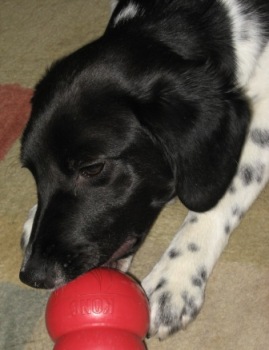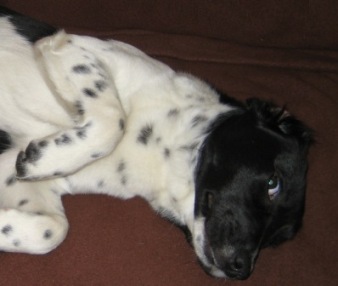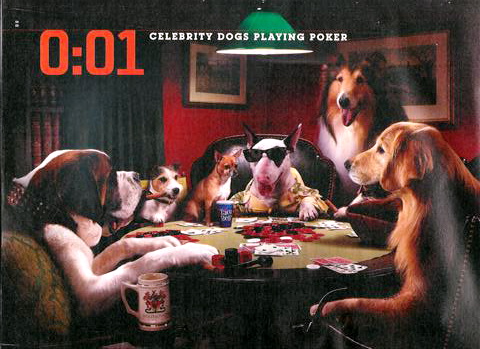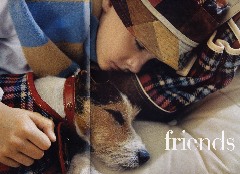My dog was hit and killed by a car yesterday morning.
It was my fault, of course–one big long “I shouldn’t have” with a dead dog at the end.
She didn’t suffer for long. She was dead by the time I got to her.
There wasn’t a mark on her, either. Makes you wonder if it wasn’t the shock of being struck that killed her.
That would have been in keeping with her temperament, in fact. She’s what they call, today, a “reactive” dog. It’s a label, and by necessity hard to define exactly, like when you call a person charming or sexy or diabolical. Yes, you can point to a set of behaviors, and behaviors are external, and so ought to lend themselves to objective description. But when you sit down to actually try it, you discover how slippery it is. You discover that, to define such a quality, you have to use subjective words–adjectives. A “reactive” dog is actually a dog that “over-reacts.” Its responses to stimuli are “exaggerated.” Only, of course, they aren’t exaggerated to the dog. But they sure as hell seem exaggerated to the people who observe them.
Put another way, we know they are exaggerated because of how we are forced to accommodate them.
My shorthand, for people who weren’t familiar with the “reactive” notion, was to say “she is the kind of dog who, if she walks into the living room, and there’s a paper bag on the floor where there wasn’t a bag before, will startle and shy away from it.”
That was my dog. Actually the bag didn’t have to be new, even. She was forever catching sight of something out of the corner of her eye that had been there since forever and jumping out of her skin.
Another way to express the same thing: perhaps you’ve seen film of the kinds of tests they do to sort puppies being considered for use as assistance dogs. They’ll bring a puppy into a room and then suddenly open an umbrella. The puppy’s reaction will fall within a broad range of potential behaviors. One pup might will notice the umbrella, and respond by approaching it to investigate. Another will hesitate longer before deciding the umbrella is okay. And then there are the puppies that will start, and shy away, and will refuse to be coaxed anywhere near that awful scary thing.
There’s my dog.
These are issues of temperament.
Temperament is the thing we should all mind when we go out canvassing for a dog–a pet dog, a companion dog, to bring into our homes. It’s far more important than breed, although breed is often used as a kind of proxy for temperament, because so often breeding has been used to select for temperament–often because certain classes of temperament correspond to a dog’s inclination to certain categories of behavior. The classic example is the border collie, which has been bred to an almost other-worldly herding drive; this drive is what, on a sheep farm, is the breed’s most prized quality. Plop down the typical border collie in a middle class suburban home, on the other hand, and you have invited a canine Loki into your midst. Nobody can know, in advance, what tricks the dog will invent, but given its tools–its raw persistent unflagging energy, it’s teeth, it’s claws–the picture will settle, most likely, into one of several cliches. Chewed up furniture, chewed up shoes, chewed up whatever-else. Children being chased and nipped.
And yet, I know someone who has a laid back border collie. The dog is calm, and quiet, and compliant, and has fit perfectly into a middle class suburban life, needing no more exercise than a daily walk, no more stimulation than an occasional living room romp with a plastic squeak toy.
People talk about dog training, but the average dog owner has a fuzzy idea of what is meant. There is the training of behaviors: teaching a dog to sit, or lie down, or stay, or come. That, it turns out, is the easy part. Any dog that is not sick can be taught these types of behaviors, with some degree of success, by just about anyone. My dog had a respectable repertoire, taught mostly via clicker and treats: along with the standard sit etc. she could roll over, she could sit up and wave, she could play dead. We owe this not to our cleverness at all but to the dogs themselves, to their inclination to take cues from us, however clumsily they are communicated.
But a dog who knows how to sit, then eats couch cushions for amusement, isn’t a dog that one could say fits into an average human household. Which brings up the other side of “dog training,” as the average dog owner would think of it–the aspect of “dog training” that is intertwined with the concept of temperament.
Not recognizing how they are intertwined sets up a great fallacy. Those dogs in the animal shelter that have been turned in because their humans have given up on them–those are the dogs I mean. Under the right circumstances, they could be marvelous companion animals, most of them, maybe all of them. But somehow, in so many cases, it doesn’t play out that way.
Again, it is a continuum. At one end, you find the dogs who are docile, pliant, calm; you find, if your search is marked by a rare grace, a dog who are all those things and quietly confident as well (incidentally, throw away the idea of “submissive” and “dominant” — highly overrated terms; a dog that is submissive but fearful–my dog–is not a dog you want in your home). At the other end, the opposite extreme, are the dogs who, if human, would be labeled sick in some way: we’d say things like “obsessive-compulsive” or “anxiety disorder” or “poor impulse control” and write a prescription or hire a therapist. And we have come up with labels for these dogs as a matter of fact: “separation anxiety” for example. And we are drugging them.
Little wonder. Adopting a dog is, for most of us, an inherently rash act, because judging temperament isn’t something most of us can do in the few minutes we spend scanning that litter of puppies or crouched on the concrete floor of an animal shelter. Yet temperament is, in the end, what makes the difference. The dog that is by nature docile-yet-confident is the dog who could be “trained” satisfactorily by anyone, even the least skilled of us–while at the other extreme are those dogs who would be a challenge even for professional trainers, people who have practiced on hundreds of dogs, who have made it their life’s work to understand what levers might be pushed on what sort of dog to get the results they want.
Most dogs and most dog owners fall, of course, in the middle, and fall as well into an uneasy compromise. In the current lingo it’s called “management,” meaning you control how much trouble the dog can get into; you give up the fiction that your dog will ever stop chewing your shoes, and instead crate him when you’re not home to stand guard over the family footwear. Yes, there’s someone out there who could train your dog not to chew your shoes, but that person isn’t you, and you have a job, and kids, and need a bit of downtime in the evening, and are subject to all the other demands and pulls of your busy life, and you give up–you put the dog in the crate. Or remember to keep the bedroom door shut. Or make whatever changes you have to make, in your life, so that the dog and the shoes are kept apart.
In the four years since I wrote a dog training book, I’ve on many occasions been solicited by people to offer dog training advice. The requests come by email, and are accompanied invariably by unhappy back stories: dogs that have bitten, dogs that just aren’t working out. I’m quick to tell these people that I’m not a professional trainer, and although I don’t say so, it may be that my advice is couched in more empathetic language because of it. Many professional trainers don’t know, or have forgotten, how baffling dogs can be to those of us who haven’t had a chance to practice on dozens or hundreds of them. Or maybe “baffling” is the wrong word, because I can tell you, I understand how to train dogs–in both senses of the term–I know how to elicit behaviors and how to modify them–I know the concepts, I’ve put them into practice, I have seen them work.
But I still felt overwhelmed by my dog: the enormity of “training” her overwhelmed me. It’s not the concept but their application.
So I can relate to how so many other dog owners feel when they realize they have a problem animal: a dog who has exceeded their capacities as a trainer.
The fact is that for my dog to have achieved a semblance of what we might call a “suitable companion animal” the investment I would have had to make would have been enormous: hours a week, for her entire life.
Take the unexpected bag on the living room floor. I know a couple different tools for innocculating a dog against such things; without going into too much detail, one is to pair the “notice the bag” event with something positive, such as treats. Eventually, the unexpected bag would have been associated with good things, enough so that encountering it would have become a different sort of experience to the dog.
All I would have had to do was repeat this, dozens of times a year, for a variety of different objects–bags, coats, boxes, new items of furniture, suitcases, Christmas trees, toolboxes–any object that might, under some conceivable circumstance, end up in my house in a spot where it wasn’t normally stowed.
A silly example, perhaps. Who cares if she shies at a suitcase?
So consider this. My dog was extremely sensitive to pain; she was extremely sensitive to any physical stimulation, so much so that it was hard to know, sometimes, if she was in pain; she acted as if things hurt when one suspects they didn’t. And so, if you touched her from behind, on her hindquarters, she would react to it by whipping her head around in alarm; as she got older she started to also, at times, snap, and then came the day the snap connected, became a nip.
I wondered at times if her hips hurt her at times, although she didn’t yelp.
Regardless, this is the sort of thing that can create huge problems in a human household, because it might one day be a child who touches her in the wrong way–and although her jaws weren’t very strong, her nip was just a nasty pinch, it hurt me, and would hurt a child more.
So I worked to modify this by touching her with a hand full of kibble. When she whipped her head around I’d open my hand and let her help herself to the food. It didn’t take too many sessions of this before the inclination to snap faded. I had “trained” her to associate being touched suddenly on her hindquarters with something positive.
But I still don’t know whether I could have ever fully exorcised the baseline behavior–the whipping around of her head–because I didn’t put in enough time and effort into it to find out. She exceeded my capacity to train out that behavior–and moreover, it’s highly likely that in time she would have reverted again to snapping, if I didn’t periodically repeat the touch-treat exercise. And of course, if she did develop hip pain–a highly likely thing, she was a Corgi, with that breed’s relatively long back and relatively weak hindquarters–all bets would be off. Like many reactive and fearful dogs, she had selected aggression as a suitable way to protect herself. Wise dog trainers repeat a truism popularized, I believe, by Jean McDonald, or maybe Ian Dunbar, along the lines of “all dogs bite, it’s just that some dogs are quicker to do it than others.” My last dog, a big mixed breed, had a high tolerance for pain–she once drove a stick through the webbing between her toes and barely seemed to notice it, let alone warn me away from it. Laykey, on the other hand, bit me once hard enough to break the skin, because she had a hurt somewhere, apparently, and I, not knowing it, had tried to pick her up.
We expect, when we bring a dog into our homes, to put in a sizeable amount of work. We know dogs need to be fed twice a day, and walked, and groomed, and played with, and petted. They truly are like toddlers that never grow up, that will always need close parenting.
But what we may not realize, or permit ourselves to acknowledge, is that a good percentage of the dogs from which we select our companions–perhaps a large majority–will have what we call “problems.” They aren’t impossible to address–far from it; the practice of behavior modification is enjoying a kind of golden age; the dog training genre is replete with accessible how-to’s able to guide any literate human in how to solve any problem dog behavior. Where it gets sticky is when you consider the size of the investment required. My dog’s “problems,” although they had a common source, took form in dozens of ways–and the investment I made in one place had no payoff anywhere else. If I was able to dampen her reaction to being touched on the hips, it had no effect on her tendency to snap at other dogs, or scream when given a shot by the vet, or show her teeth if approached by a strange child–behaviors which in some cases she exhibited from the day I brought her home, and which in other cases she began exhibiting as she got older, as if her estimation that the world was a dangerous place best kept at bay seemed to solidify or even escalate as she grew older–and she wasn’t even old enough yet, at eight, to be excused as truly cranky.
Don’t leave me training advice, please. My point is not that I didn’t know what to do with her: I did. I spent years studying dog training; I immersed myself in it; during the period I co-wrote Outwitting Dogs, I had the opportunity to pick the brains of one of the best professional trainers alive today. I did all the right things with her from the beginning, starting with puppy kindergarten and socializing and foundation obedience. Nor did I assume that her training would one day “be done”–I knew full well that it never is. My point is that she needed, as it turned out, more than occasional refreshers: to make her a “suitable companion” would have been a part-time job, for the rest of the dog’s life–hours a week, literally. An enormous investment on my part, of time and money and ingenuity. And had I taken a break at any time, slacked off my effort at all, she would have immediately begun to backslide–because at bottom the problem was her nature, and my “training” was an effort to counter her nature, to brace her world continually against it. Which can be done. But the effort required is constant and enormous.
So I compromised, like most dog owners with “problem dogs” do. I crated her when children came over to visit my daughter. I kept her away from other dogs. I accepted the fact that I would probably be bitten again, at some point, probably more than once, as she aged and developed the inevitable aches and pains, which I wouldn’t discover until I touched her in the wrong place, in the wrong way.
I knew also this made me a failure; with my advantages, I should have been able to shape my Laykey into that perfect companion, and could have, if I had been more . . . something. But she exceeded my capacities; she required someone with more time, with more skills, someone more willing to commit more than I was.
Some might say she exceeded my capacity to love. I guess it depends on what our dogs are owed. I took care of her physical needs; I fed her human-grade food, I made sure she had chew toys always on hand; I got her vet care when she needed it; when she came looking to be petted I petted her. And you know, within a dog’s world, absent pain or thirst or hunger things are generally just ducky; so I think I’m on solid ground to say she judged her life to be a good one, insofar that dogs can judge such things. After all, if she objected to having her hips touched, it wasn’t her that was bothered by it, it was me. For her it was a fleeting thing, over as soon as it was over–it was me who brooded on it, and on my own inadequacies, and her breeder’s, and the notion of purebred dogs, and the lack of a roadmap that would help us amateur dog people negotiate the process of adopting a dog.
I started this post by confessing that her death is my fault. As it was. Such is the bargain we make when we take an animal into our lives: everything that follows becomes our responsibility, every pain they suffer becomes our fault, and more than we would wish the decision that they will die, when the time comes, is more or less in our hands.
For all that, the pain I feel isn’t guilt. It’s grief. I lost my little dog yesterday. She’ll never look up at me with her bright eyes and pricked ears again. I’ve no reason any more to singsong her name, Laykey Laykey Lou Lou, Laykey Laykey Lou Lou.
It hurts. It hurts and shows no sign of stopping.
I’m sorry, little dog. Good-bye, little dog. I’m so sorry.









 Susan has sent me some more pics of Camilla to post here. Look at that sweetie! She doesn’t look at all like a dog who would chew a slipper now, does she!
Susan has sent me some more pics of Camilla to post here. Look at that sweetie! She doesn’t look at all like a dog who would chew a slipper now, does she!
